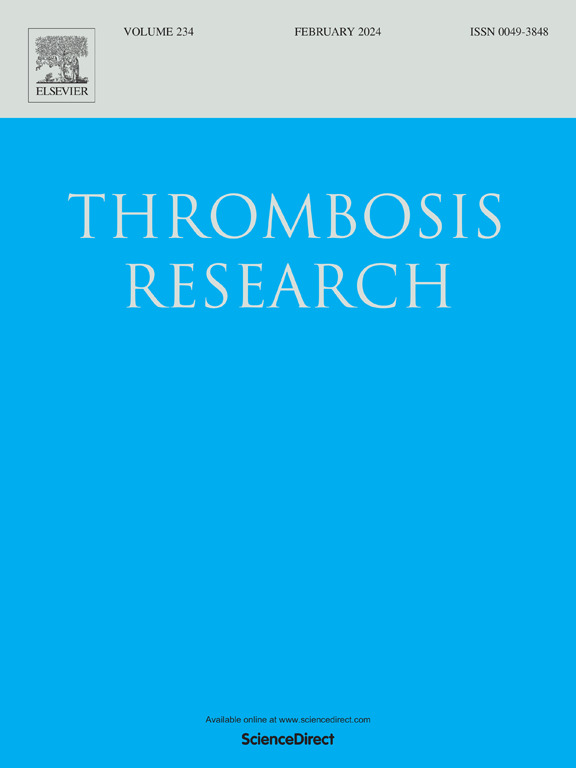Absorption and anticoagulant management of rivaroxaban in patients with short bowel syndrome
IF 3.7
3区 医学
Q1 HEMATOLOGY
引用次数: 0
Abstract
Background
Patients with short bowel syndrome (SBS) often rely on parenteral nutrition via central venous catheters, increasing the risk of thrombosis. Many also require long-term anticoagulation due to other conditions. While warfarin was traditionally preferred, direct oral anticoagulants like rivaroxaban are now more common. However, no larger studies have assessed rivaroxaban absorption in SBS patients.
Aim
The aim of this study was to do a further characterization of the absorption of rivaroxaban in patients with SBS. The secondary aim was to assess thromboses and bleeding events in patients on continuous treatment with rivaroxaban.
Methods
A retrospective, five-year cohort study following a 20 mg dose rivaroxaban, plasma concentrations were measured at 1.5, 2.5, and 3.5 h, in 34 patients with SBS. Thrombotic and bleeding events and clinical data were sought in medical records. Patients were characterized with the length of the small intestine and the weekly volume of intravenous fluid support.
Results
The Cmax of rivaroxaban correlated positively with intestinal length (p = 0.005) and negatively with the weekly total fluid support (p = 0.0001). A cut-off value regarding intestinal length and adequate absorption was estimated between 125 and 150 cm. In a cumulative follow up time of 19.6 years, one event of thrombosis and one event of bleeding was observed.
Conclusion
Rivaroxaban absorption correlates with intestinal length and functionality. Anticipating few thrombotic and bleeding events during treatment, rivaroxaban seemed efficient and safe, but further studies are warranted to clarify its role in SBS patients.
利伐沙班在短肠综合征患者中的吸收和抗凝管理
背景:短肠综合征(SBS)患者通常依赖于通过中心静脉导管进行肠外营养,这增加了血栓形成的风险。由于其他原因,许多人还需要长期抗凝。虽然华法林传统上是首选,但像利伐沙班这样的直接口服抗凝剂现在更常见。然而,没有更大规模的研究评估SBS患者对利伐沙班的吸收。目的本研究的目的是进一步表征利伐沙班在SBS患者中的吸收。次要目的是评估持续接受利伐沙班治疗的患者的血栓和出血事件。方法对34例SBS患者进行回顾性、5年队列研究,在给予20mg利伐沙班治疗后,分别在1.5、2.5和3.5 h测量血药浓度。在医疗记录中寻找血栓和出血事件和临床数据。患者以小肠长度和每周静脉液体支持量为特征。结果利伐沙班Cmax与肠道长度呈正相关(p = 0.005),与周总液体支持量呈负相关(p = 0.0001)。肠道长度和充分吸收的临界值估计在125至150厘米之间。在19.6年的累计随访中,观察到1例血栓形成和1例出血事件。结论利伐沙班的吸收与肠道长度和功能有关。预计在治疗过程中很少发生血栓和出血事件,利伐沙班似乎是有效和安全的,但需要进一步的研究来阐明其在SBS患者中的作用。
本文章由计算机程序翻译,如有差异,请以英文原文为准。
求助全文
约1分钟内获得全文
求助全文
来源期刊

Thrombosis research
医学-外周血管病
CiteScore
14.60
自引率
4.00%
发文量
364
审稿时长
31 days
期刊介绍:
Thrombosis Research is an international journal dedicated to the swift dissemination of new information on thrombosis, hemostasis, and vascular biology, aimed at advancing both science and clinical care. The journal publishes peer-reviewed original research, reviews, editorials, opinions, and critiques, covering both basic and clinical studies. Priority is given to research that promises novel approaches in the diagnosis, therapy, prognosis, and prevention of thrombotic and hemorrhagic diseases.
 求助内容:
求助内容: 应助结果提醒方式:
应助结果提醒方式:


